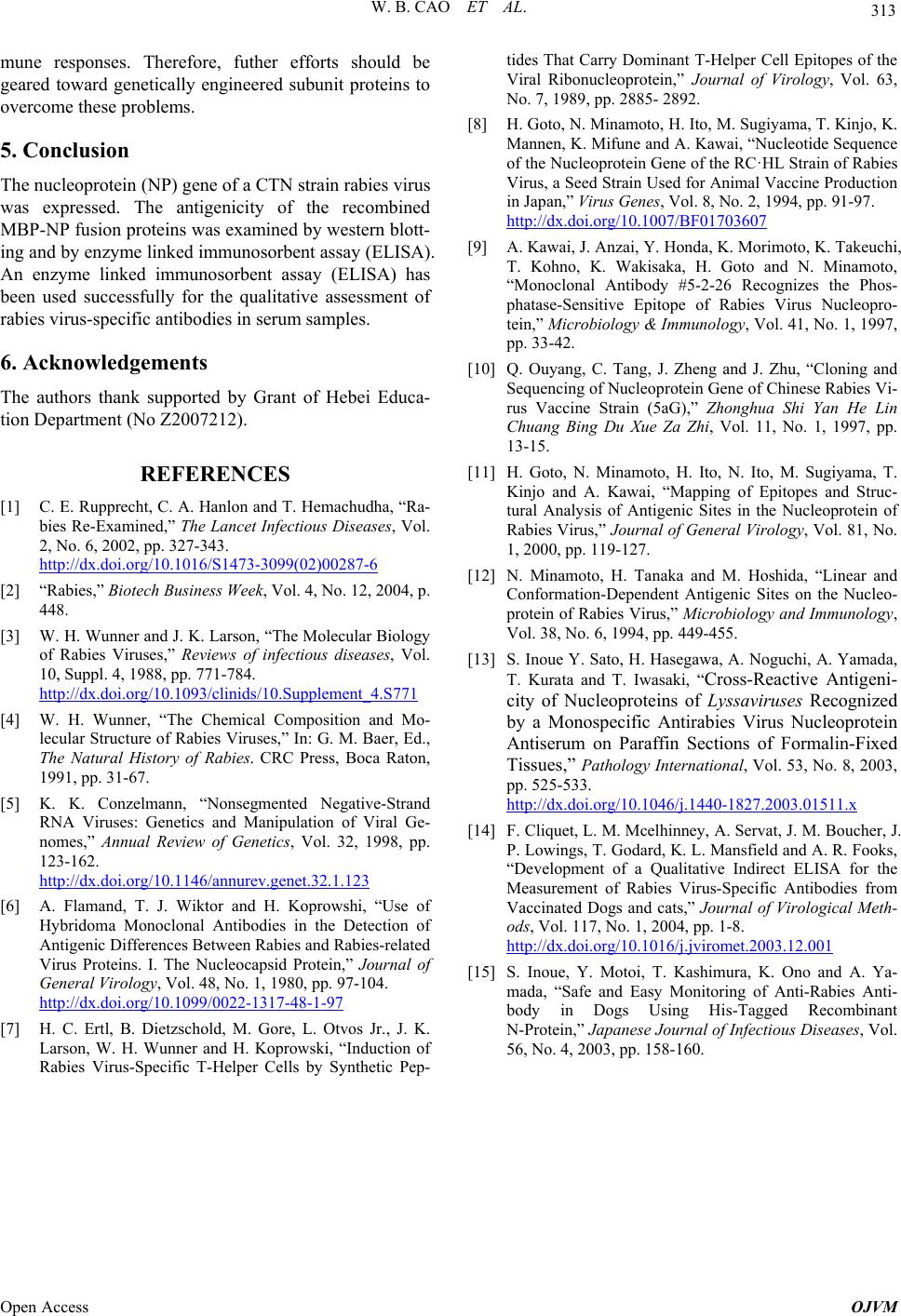
W. B. CAO ET AL. 313
mune responses. Therefore, futher efforts should be
geared toward genetically engineered subunit proteins to
overcome these problems.
5. Conclusion
The nucleoprotein (NP) gene of a CTN strain rabies virus
was expressed. The antigenicity of the recombined
MBP-NP fusion proteins was examined by western blott-
ing and by enzyme linked immunosorbent assay (ELISA).
An enzyme linked immunosorbent assay (ELISA) has
been used successfully for the qualitative assessment of
rabies virus-specific antibodies in serum samples.
6. Acknowledgements
The authors thank supported by Grant of Hebei Educa-
tion Department (No Z2007212).
REFERENCES
[1] C. E. Rupprecht, C. A. Hanlon and T. Hemachudha, “Ra-
bies Re-Examined,” The Lancet Infectious Diseases, Vol.
2, No. 6, 2002, pp. 327-343.
http://dx.doi.org/10.1016/S1473-3099(02)00287-6
[2] “Rabies,” Biotech Business Week, Vol. 4, No. 12, 2004, p.
448.
[3] W. H. Wunner and J. K. Larson, “The Molecular Biology
of Rabies Viruses,” Reviews of infectious diseases, Vol.
10, Suppl. 4, 1988, pp. 771-784.
http://dx.doi.org/10.1093/clinids/10.Supplement_4.S771
[4] W. H. Wunner, “The Chemical Composition and Mo-
lecular Structure of Rabies Viruses,” In: G. M. Baer, Ed.,
The Natural History of Rabies. CRC Press, Boca Raton,
1991, pp. 31-67.
[5] K. K. Conzelmann, “Nonsegmented Negative-Strand
RNA Viruses: Genetics and Manipulation of Viral Ge-
nomes,” Annual Review of Genetics, Vol. 32, 1998, pp.
123-162.
http://dx.doi.org/10.1146/annurev.genet.32.1.123
[6] A. Flamand, T. J. Wiktor and H. Koprowshi, “Use of
Hybridoma Monoclonal Antibodies in the Detection of
Antigenic Differences Between Rabies and Rabies-related
Virus Proteins. I. The Nucleocapsid Protein,” Journal of
General Virology, Vol. 48, No. 1, 1980, pp. 97-104.
http://dx.doi.org/10.1099/0022-1317-48-1-97
[7] H. C. Ertl, B. Dietzschold, M. Gore, L. Otvos Jr., J. K.
Larson, W. H. Wunner and H. Koprowski, “Induction of
Rabies Virus-Specific T-Helper Cells by Synthetic Pep-
tides That Carry Dominant T-Helper Cell Epitopes of the
Viral Ribonucleoprotein,” Journal of Virology, Vol. 63,
No. 7, 1989, pp. 2885- 2892.
[8] H. Goto, N. Minamoto, H. Ito, M. Sugiyama, T. Kinjo, K.
Mannen, K. Mifune and A. Kawai, “Nucleotide Sequence
of the Nucleoprotein Gene of the RC·HL Strain of Rabies
Virus, a Seed Strain Used for Animal Vaccine Production
in Japan,” Virus Genes, Vol. 8, No. 2, 1994, pp. 91-97.
http://dx.doi.org/10.1007/BF01703607
[9] A. Kawai, J. Anzai, Y. Honda, K. Morimoto, K. Takeuchi,
T. Kohno, K. Wakisaka, H. Goto and N. Minamoto,
“Monoclonal Antibody #5-2-26 Recognizes the Phos-
phatase-Sensitive Epitope of Rabies Virus Nucleopro-
tein,” Microbiology & Immunology, Vol. 41, No. 1, 1997,
pp. 33-42.
[10] Q. Ouyang, C. Tang, J. Zheng and J. Zhu, “Cloning and
Sequencing of Nucleoprotein Gene of Chinese Rabies Vi-
rus Vaccine Strain (5aG),” Zhonghua Shi Yan He Lin
Chuang Bing Du Xue Za Zhi, Vol. 11, No. 1, 1997, pp.
13-15.
[11] H. Goto, N. Minamoto, H. Ito, N. Ito, M. Sugiyama, T.
Kinjo and A. Kawai, “Mapping of Epitopes and Struc-
tural Analysis of Antigenic Sites in the Nucleoprotein of
Rabies Virus,” Journal of General Virology, Vol. 81, No.
1, 2000, pp. 119-127.
[12] N. Minamoto, H. Tanaka and M. Hoshida, “Linear and
Conformation-Dependent Antigenic Sites on the Nucleo-
protein of Rabies Virus,” Microbiology and Immunology,
Vol. 38, No. 6, 1994, pp. 449-455.
[13] S. Inoue Y. Sato, H. Hasegawa, A. Noguchi, A. Yamada,
T. Kurata and T. Iwasaki, “Cross-Reactive Antigeni-
city of Nucleoproteins of Lyssaviruses Recognized
by a Monospecific Antirabies Virus Nucleoprotein
Antiserum on Paraffin Sections of Formalin-Fixed
Tissues,” Pathology International, Vol. 53, No. 8, 2003,
pp. 525-533.
http://dx.doi.org/10.1046/j.1440-1827.2003.01511.x
[14] F. Cliquet, L. M. Mcelhinney, A. Servat, J. M. Boucher, J.
P. Lowings, T. Godard, K. L. Mansfield and A. R. Fooks,
“Development of a Qualitative Indirect ELISA for the
Measurement of Rabies Virus-Specific Antibodies from
Vaccinated Dogs and cats,” Journal of Virological Meth-
ods, Vol. 117, No. 1, 2004, pp. 1-8.
http://dx.doi.org/10.1016/j.jviromet.2003.12.001
[15] S. Inoue, Y. Motoi, T. Kashimura, K. Ono and A. Ya-
mada, “Safe and Easy Monitoring of Anti-Rabies Anti-
body in Dogs Using His-Tagged Recombinant
N-Protein,” Japanese Journal of Infectious Diseases, Vol.
56, No. 4, 2003, pp. 158-160.
Open Access OJVM